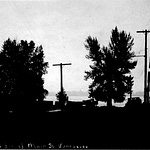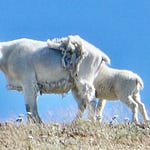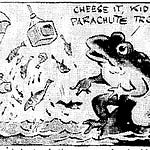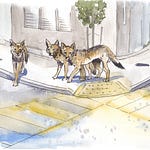Over the weekend, I went out for a quick walk around our neighborhood, which I have done thousands of times. So it was rather exciting to discover something new. In particular, I walked on a path I had never trod, much less seen. It wasn’t terribly long, perhaps 50 feet, or challenging or scenic. Located at the end of a Dead End road, the dirt path simply allowed me to cut easily through blackberries and down a short slope to the back end of a parking lot. Still I felt a frisson of excitement.
Doing so saved me about a quarter mile of walking, but that wasn’t the point either. What I gained was further knowledge of my home place, of the pathways that people, and perhaps animals, use to navigate. Part of my joy was knowing that I was not the first to consider this potential linkage of two points. I had now joined an anonymous club of those who strayed off the main path and found a new way to go. Plus, it was a route not down on any map, like many another true place, as Mr. Melville wrote in Moby-Dick.
These unofficial paths come in many guises. Some are signed, others seem home made, discretely blending in to their surroundings, a few are hidden and require probing to find, and one I know of requires passing under an arch of laurel. I have gotten my feet wet crossing one on boards through a wetland. On another blackberries tore at my jacket. But most of these guerrilla paths require little more than being aware and a willingness to step off the standard route.
A few of these bypass paths actually show up on maps, which doesn’t lessen my joy in taking them. They typically are semi-official routes, for example, linking streets severed by a ridge (which might involve stairs) or valley or deemed too steep to climb in a car. In many cases, though, no natural feature provides the clue why and I am left making up a story that explains the disconnection: lovers’ property dispute, a malevolent surveyor, an ill-informed cartographer, pure unadulterated greed. No matter why, I like these paths because they are caltrops in the tires of car culture: cars and their ilk are not allowed, walkers welcome. As such, these paths are small acts of rebellion against the dominance of the car and the grid.

Another appealing aspect of this type of path is that they often reveal unseen or poorly understood relationships of space. In our modern society, where so many of one’s geographic perceptions of place are based on roads, we only experience linkages by the routes designed for cars. For example, when we were at Deception Pass, we stayed in the campground, which had a one-way road. When we explored on foot and found an unofficial path, we discovered how the bathroom that seemed so far away was actually quite near.
Linking paths, such as the one I first used this weekend, are what I call adult paths. The name doesn’t mean that kids weren’t the first to make them, but this type of path is about practicality. They go directly from point A to point B and are the ones that might make it onto maps. For instance, several linking paths show up on Internet-based maps of Seattle. Another style of adult path is one found in parks or other public spaces. We might want to call these trails. Clearly designated and maintained, routes such as this are important because they help protect an area by keeping most people following the same route. (Let me be clear, I am no fan of short cuts on trails or social trails in fragile and wilder ecosystems.)
In contrast, kid paths don’t hue to order and often have no practical destination. I think back to my childhood of growing up near what we called the Ravine. Seemingly seldom visited by adults, this relatively wild green space was a perfect place for kids to roam; the routes we followed reflected what was important to us. They might lead to a fort, a secret “room” in the foliage, an animal’s home. They were about discovery and adventure, of being outside with few cares except to have fun.
I still like to follow such paths in Seattle’s many green spaces, for the reasons I did as a kid. I further appreciate them because they often take me to the unkempt part of a green space, where the natural world is most natural in the urban environment. No one worries about liability, and limbs, foliage, tree trunks, and stumps are allowed to moulder and decompose naturally, without concerns that a human visitor will suffer from the disarray. Unfortunately, but understandably, natural death such as this is often banished from urban spaces.
A sense of discovery. Getting exercise. Seeing decay and decomposition. And, you wonder why I am such a fan of getting out and walking.
Big news: Here’s the link to register for the book launch of Wild in Seattle: Stories at the Crossroads of People and Nature. It’ll be at the Burke Museum on April 16 at 6pm. I am very excited about this event as I will be chatting about the book with Elizabeth Person, who created the wonderful illustrations. Space is limited.
Quote I like - “I go to places. I walk when I’m there, I look around, I write about what I see and feel. It’s not the only thing I do with my life, but it’s probably the best part.”
Geoff Nicholson, Walking on Thin Air: A Life’s Journey in 99 Steps













Share this post